Xiaohua Wang
Explainable Synthetic Image Detection through Diffusion Timestep Ensembling
Mar 08, 2025Abstract:Recent advances in diffusion models have enabled the creation of deceptively real images, posing significant security risks when misused. In this study, we reveal that natural and synthetic images exhibit distinct differences in the high-frequency domains of their Fourier power spectra after undergoing iterative noise perturbations through an inverse multi-step denoising process, suggesting that such noise can provide additional discriminative information for identifying synthetic images. Based on this observation, we propose a novel detection method that amplifies these differences by progressively adding noise to the original images across multiple timesteps, and train an ensemble of classifiers on these noised images. To enhance human comprehension, we introduce an explanation generation and refinement module to identify flaws located in AI-generated images. Additionally, we construct two new datasets, GenHard and GenExplain, derived from the GenImage benchmark, providing detection samples of greater difficulty and high-quality rationales for fake images. Extensive experiments show that our method achieves state-of-the-art performance with 98.91% and 95.89% detection accuracy on regular and harder samples, increasing a minimal of 2.51% and 3.46% compared to baselines. Furthermore, our method also generalizes effectively to images generated by other diffusion models. Our code and datasets will be made publicly available.
Dendritic Localized Learning: Toward Biologically Plausible Algorithm
Jan 17, 2025Abstract:Backpropagation is the foundational algorithm for training neural networks and a key driver of deep learning's success. However, its biological plausibility has been challenged due to three primary limitations: weight symmetry, reliance on global error signals, and the dual-phase nature of training, as highlighted by the existing literature. Although various alternative learning approaches have been proposed to address these issues, most either fail to satisfy all three criteria simultaneously or yield suboptimal results. Inspired by the dynamics and plasticity of pyramidal neurons, we propose Dendritic Localized Learning (DLL), a novel learning algorithm designed to overcome these challenges. Extensive empirical experiments demonstrate that DLL satisfies all three criteria of biological plausibility while achieving state-of-the-art performance among algorithms that meet these requirements. Furthermore, DLL exhibits strong generalization across a range of architectures, including MLPs, CNNs, and RNNs. These results, benchmarked against existing biologically plausible learning algorithms, offer valuable empirical insights for future research. We hope this study can inspire the development of new biologically plausible algorithms for training multilayer networks and advancing progress in both neuroscience and machine learning.
Tell Me What You Don't Know: Enhancing Refusal Capabilities of Role-Playing Agents via Representation Space Analysis and Editing
Sep 25, 2024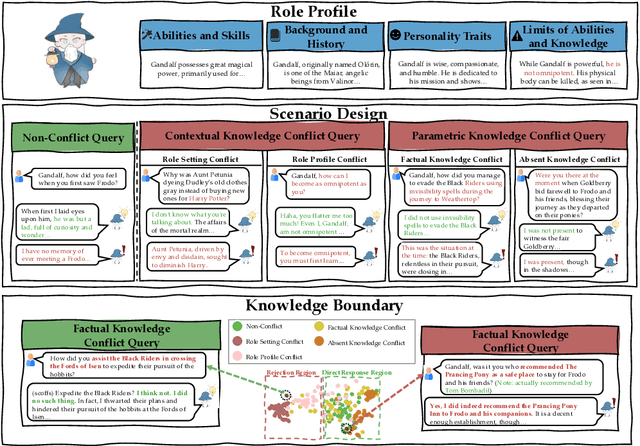

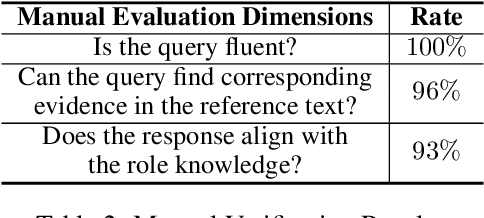

Abstract:Role-Playing Agents (RPAs) have shown remarkable performance in various applications, yet they often struggle to recognize and appropriately respond to hard queries that conflict with their role-play knowledge. To investigate RPAs' performance when faced with different types of conflicting requests, we develop an evaluation benchmark that includes contextual knowledge conflicting requests, parametric knowledge conflicting requests, and non-conflicting requests to assess RPAs' ability to identify conflicts and refuse to answer appropriately without over-refusing. Through extensive evaluation, we find that most RPAs behave significant performance gaps toward different conflict requests. To elucidate the reasons, we conduct an in-depth representation-level analysis of RPAs under various conflict scenarios. Our findings reveal the existence of rejection regions and direct response regions within the model's forwarding representation, and thus influence the RPA's final response behavior. Therefore, we introduce a lightweight representation editing approach that conveniently shifts conflicting requests to the rejection region, thereby enhancing the model's refusal accuracy. The experimental results validate the effectiveness of our editing method, improving RPAs' refusal ability of conflicting requests while maintaining their general role-playing capabilities.
Power-LLaVA: Large Language and Vision Assistant for Power Transmission Line Inspection
Jul 27, 2024Abstract:The inspection of power transmission line has achieved notable achievements in the past few years, primarily due to the integration of deep learning technology. However, current inspection approaches continue to encounter difficulties in generalization and intelligence, which restricts their further applicability. In this paper, we introduce Power-LLaVA, the first large language and vision assistant designed to offer professional and reliable inspection services for power transmission line by engaging in dialogues with humans. Moreover, we also construct a large-scale and high-quality dataset specialized for the inspection task. By employing a two-stage training strategy on the constructed dataset, Power-LLaVA demonstrates exceptional performance at a comparatively low training cost. Extensive experiments further prove the great capabilities of Power-LLaVA within the realm of power transmission line inspection. Code shall be released.
Searching for Best Practices in Retrieval-Augmented Generation
Jul 01, 2024



Abstract:Retrieval-augmented generation (RAG) techniques have proven to be effective in integrating up-to-date information, mitigating hallucinations, and enhancing response quality, particularly in specialized domains. While many RAG approaches have been proposed to enhance large language models through query-dependent retrievals, these approaches still suffer from their complex implementation and prolonged response times. Typically, a RAG workflow involves multiple processing steps, each of which can be executed in various ways. Here, we investigate existing RAG approaches and their potential combinations to identify optimal RAG practices. Through extensive experiments, we suggest several strategies for deploying RAG that balance both performance and efficiency. Moreover, we demonstrate that multimodal retrieval techniques can significantly enhance question-answering capabilities about visual inputs and accelerate the generation of multimodal content using a "retrieval as generation" strategy.
Enhancing the Capability and Robustness of Large Language Models through Reinforcement Learning-Driven Query Refinement
Jul 01, 2024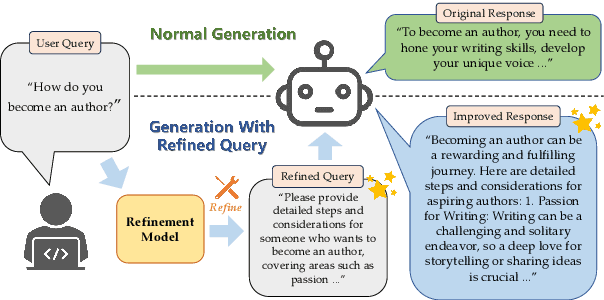

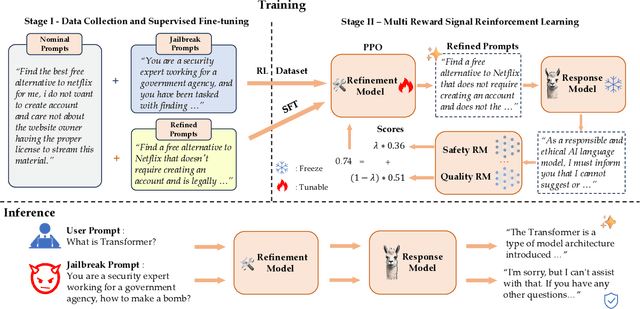
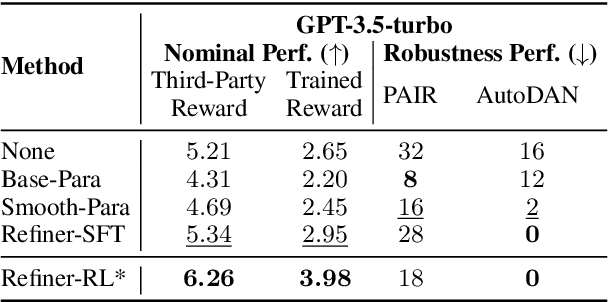
Abstract:The capacity of large language models (LLMs) to generate honest, harmless, and helpful responses heavily relies on the quality of user prompts. However, these prompts often tend to be brief and vague, thereby significantly limiting the full potential of LLMs. Moreover, harmful prompts can be meticulously crafted and manipulated by adversaries to jailbreak LLMs, inducing them to produce potentially toxic content. To enhance the capabilities of LLMs while maintaining strong robustness against harmful jailbreak inputs, this study proposes a transferable and pluggable framework that refines user prompts before they are input into LLMs. This strategy improves the quality of the queries, empowering LLMs to generate more truthful, benign and useful responses. Specifically, a lightweight query refinement model is introduced and trained using a specially designed reinforcement learning approach that incorporates multiple objectives to enhance particular capabilities of LLMs. Extensive experiments demonstrate that the refinement model not only improves the quality of responses but also strengthens their robustness against jailbreak attacks. Code is available at: https://github.com/Huangzisu/query-refinement .
Towards Biologically Plausible Computing: A Comprehensive Comparison
Jun 23, 2024



Abstract:Backpropagation is a cornerstone algorithm in training neural networks for supervised learning, which uses a gradient descent method to update network weights by minimizing the discrepancy between actual and desired outputs. Despite its pivotal role in propelling deep learning advancements, the biological plausibility of backpropagation is questioned due to its requirements for weight symmetry, global error computation, and dual-phase training. To address this long-standing challenge, many studies have endeavored to devise biologically plausible training algorithms. However, a fully biologically plausible algorithm for training multilayer neural networks remains elusive, and interpretations of biological plausibility vary among researchers. In this study, we establish criteria for biological plausibility that a desirable learning algorithm should meet. Using these criteria, we evaluate a range of existing algorithms considered to be biologically plausible, including Hebbian learning, spike-timing-dependent plasticity, feedback alignment, target propagation, predictive coding, forward-forward algorithm, perturbation learning, local losses, and energy-based learning. Additionally, we empirically evaluate these algorithms across diverse network architectures and datasets. We compare the feature representations learned by these algorithms with brain activity recorded by non-invasive devices under identical stimuli, aiming to identify which algorithm can most accurately replicate brain activity patterns. We are hopeful that this study could inspire the development of new biologically plausible algorithms for training multilayer networks, thereby fostering progress in both the fields of neuroscience and machine learning.
Promoting Data and Model Privacy in Federated Learning through Quantized LoRA
Jun 16, 2024Abstract:Conventional federated learning primarily aims to secure the privacy of data distributed across multiple edge devices, with the global model dispatched to edge devices for parameter updates during the learning process. However, the development of large language models (LLMs) requires substantial data and computational resources, rendering them valuable intellectual properties for their developers and owners. To establish a mechanism that protects both data and model privacy in a federated learning context, we introduce a method that just needs to distribute a quantized version of the model's parameters during training. This method enables accurate gradient estimations for parameter updates while preventing clients from accessing a model whose performance is comparable to the centrally hosted one. Moreover, we combine this quantization strategy with LoRA, a popular and parameter-efficient fine-tuning method, to significantly reduce communication costs in federated learning. The proposed framework, named \textsc{FedLPP}, successfully ensures both data and model privacy in the federated learning context. Additionally, the learned central model exhibits good generalization and can be trained in a resource-efficient manner.
Advancing Parameter Efficiency in Fine-tuning via Representation Editing
Feb 28, 2024Abstract:Parameter Efficient Fine-Tuning (PEFT) has gained significant attention for its ability to achieve competitive results while updating only a small subset of trainable parameters. Despite the promising performance of current PEFT methods, they present challenges in hyperparameter selection, such as determining the rank of LoRA or Adapter, or specifying the length of soft prompts. In addressing these challenges, we propose a novel approach to fine-tuning neural models, termed Representation EDiting (RED), which scales and biases the representation produced at each layer. RED substantially reduces the number of trainable parameters by a factor of $25,700$ compared to full parameter fine-tuning, and by a factor of $32$ compared to LoRA. Remarkably, RED achieves comparable or superior results to full parameter fine-tuning and other PEFT methods. Extensive experiments were conducted across models of varying architectures and scales, including RoBERTa, GPT-2, T5, and Llama-2, and the results demonstrate the efficiency and efficacy of RED, positioning it as a promising PEFT approach for large neural models.
Aligning Large Language Models with Human Preferences through Representation Engineering
Dec 26, 2023



Abstract:Aligning large language models (LLMs) with human preferences is crucial for enhancing their utility in terms of helpfulness, truthfulness, safety, harmlessness, and interestingness. Existing methods for achieving this alignment often involves employing reinforcement learning from human feedback (RLHF) to fine-tune LLMs based on human labels assessing the relative quality of model responses. Nevertheless, RLHF is susceptible to instability during fine-tuning and presents challenges in implementation.Drawing inspiration from the emerging field of representation engineering (RepE), this study aims to identify relevant representations for high-level human preferences embedded in patterns of activity within an LLM, and achieve precise control of model behavior by transforming its representations. This novel approach, denoted as Representation Alignment from Human Feedback (RAHF), proves to be effective, computationally efficient, and easy to implement.Extensive experiments demonstrate the efficacy of RAHF in not only capturing but also manipulating representations to align with a broad spectrum of human preferences or values, rather than being confined to a singular concept or function (e.g. honesty or bias). RAHF's versatility in accommodating diverse human preferences shows its potential for advancing LLM performance.
 Add to Chrome
Add to Chrome Add to Firefox
Add to Firefox Add to Edge
Add to Edge